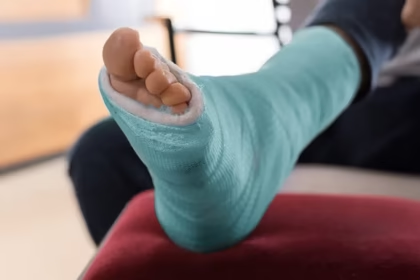Plantar fasciitis affects the thick band of tissue that connects your heel bone to your toes. This tissue, called the plantar fascia, acts as a shock absorber, supporting the arch of your foot. When it becomes inflamed, it leads to a stabbing pain that usually occurs with your first steps in the morning. Here is more information about the causes of this condition and available treatment options:
Causes of Plantar Fasciitis
The plantar fascia endures heavy wear and tear throughout your daily life. Tension and stress on this tissue may cause small tears, and repeated stretching and tearing lead to inflammation and pain. While the exact cause is not always clear, several factors may increase your risk of developing plantar fasciitis.
Certain types of exercise may contribute to its onset. Foot mechanics also play a role. Individuals with flat feet, high arches, or atypical walking patterns may experience an uneven distribution of weight, which adds stress to the plantar fascia.
Occupations that require you to be on your feet for long hours can also strain this tissue. Wearing shoes with inadequate support, especially on hard surfaces, does not provide proper shock absorption for your feet. Over time, these factors can lead to small tears in the plantar fascia, resulting in pain and inflammation.
Treatment Options
A variety of non-surgical treatments are available to help manage the symptoms of plantar fasciitis. Your healthcare provider may suggest a path based on your specific situation. Many people find relief through a combination of these methods.
Initial approaches often focus on conservative care. Simple methods include rest, ice, and stretching exercises designed to soothe the plantar fascia. Over-the-counter pain relievers may help reduce inflammation and discomfort. For more targeted relief, several treatments are available:
- Orthotics inserts: Shoe inserts or custom-fitted orthotics help distribute pressure more evenly across your feet, providing support to the arch and cushioning the heel.
- Cortisone injections: A corticosteroid injection administered by a doctor directly into the damaged section of the fascia may provide temporary pain relief by reducing inflammation.
- Physical therapy: A physical therapist guides you through exercises to stretch the plantar fascia and Achilles tendon, as well as strengthen lower leg muscles, which helps stabilize your ankle and heel.
- Shockwave therapy: This non-invasive procedure uses sound waves to stimulate healing in the affected tissue. It is typically used for chronic cases that have not responded to other treatments.
- MLS Therapy: Multiwave locked system (MLS) laser therapy uses specific wavelengths of light to reduce inflammation and pain, promoting tissue repair without generating heat.
Surgical Options
When conservative treatments do not provide relief after several months, surgery might be an option. A surgical procedure is typically reserved for cases of severe, persistent pain. This procedure may be performed either as an open surgery or through a smaller incision with endoscopic tools. Your doctor will discuss the details and what to expect from a surgical approach.
Get Treated for Plantar Fasciitis
A range of treatment options exists to address the discomfort of plantar fasciitis and help you get back on your feet. A proper evaluation is the first step toward identifying the right course of action for your specific needs. If you are experiencing persistent heel pain, schedule a consultation with our team to explore your treatment options and start your journey toward relief.









